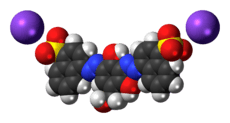Brown HT
 | |
 | |
| Names | |
|---|---|
| IUPAC name
Disodium 4-[(2E)-2-[(5Z)-3-(hydroxymethyl)-2,6-dioxo-5-[(4-sulfonatonaphthalen-1-yl)hydrazinylidene]-1-cyclohex-3-enylidene]hydrazinyl]naphthalene-1-sulfonate | |
| Other names
Chocolate Brown HT, Food Brown 3, C.I. 20285, E155 | |
| Identifiers | |
| 4553-89-3 | |
| 3D model (Jmol) | Interactive image |
| ChEMBL | ChEMBL1697823 |
| ChemSpider | 21172062 |
| ECHA InfoCard | 100.022.659 |
| E number | E155 (colours) |
| PubChem | 6536776 |
| |
| |
| Properties | |
| C27H18N4Na2O9S2 | |
| Molar mass | 652.56 g/mol |
| Except where otherwise noted, data are given for materials in their standard state (at 25 °C [77 °F], 100 kPa). | |
| Infobox references | |
Brown HT, also called Chocolate Brown HT, Food Brown 3, and C.I. 20285, is a brown synthetic coal tar diazo dye.
When used as a food dye, its E number is E155. It is used to substitute cocoa or caramel as a colorant. It is used mainly in chocolate cakes, but also in milk and cheeses, yogurts, jams, fruit products, fish, and other products.[1] It may provoke allergic reactions in asthmatics, people sensitive to aspirin, and other sensitive individuals, and may induce skin sensitivity.
It is one of the food colorings that the Hyperactive Children's Support Group recommends be eliminated from the diet of children. It is banned in Austria, Belgium, Denmark, France, Germany, United States, Norway, Switzerland, and Sweden.[2]
References
This article is issued from Wikipedia - version of the 12/31/2015. The text is available under the Creative Commons Attribution/Share Alike but additional terms may apply for the media files.